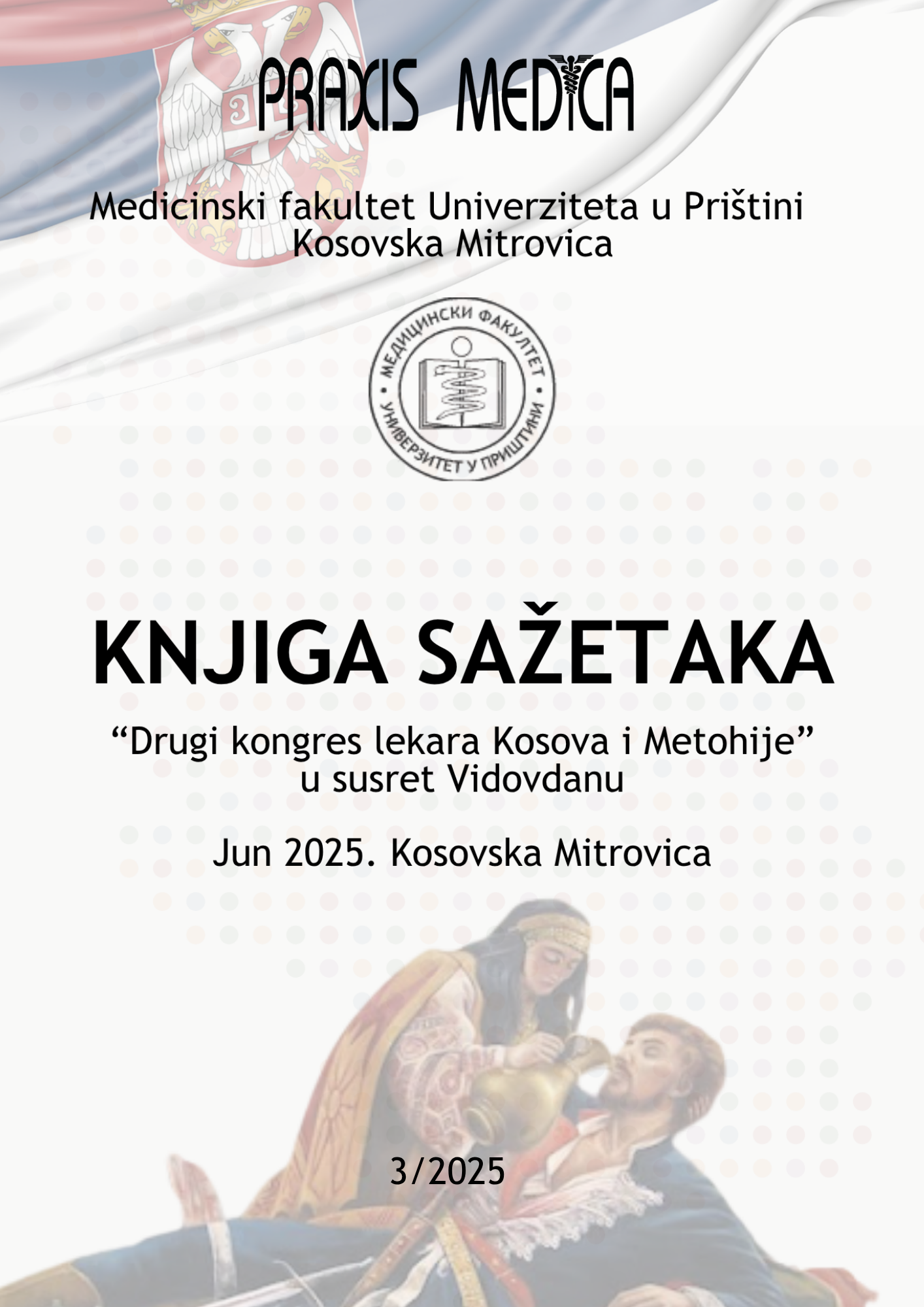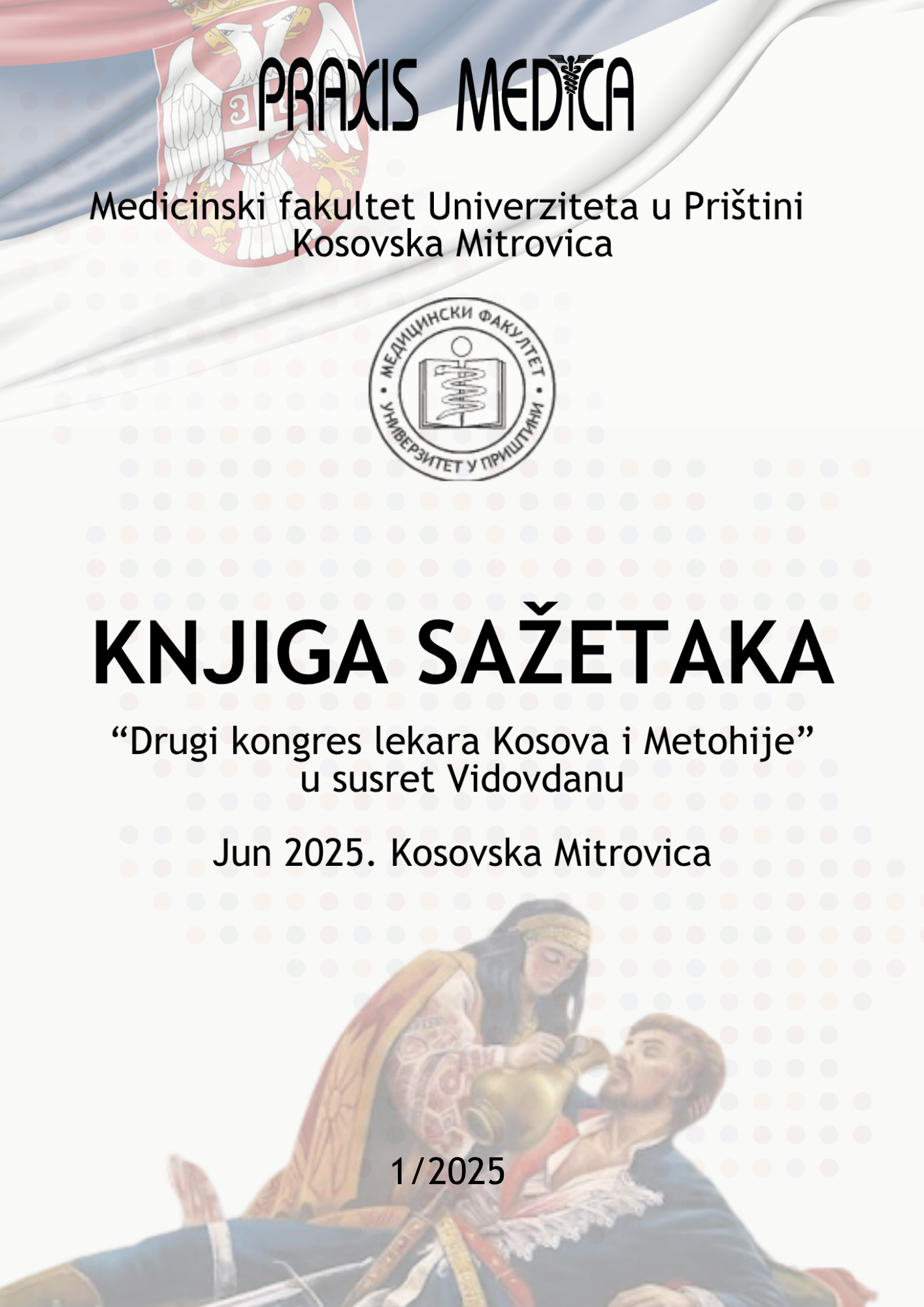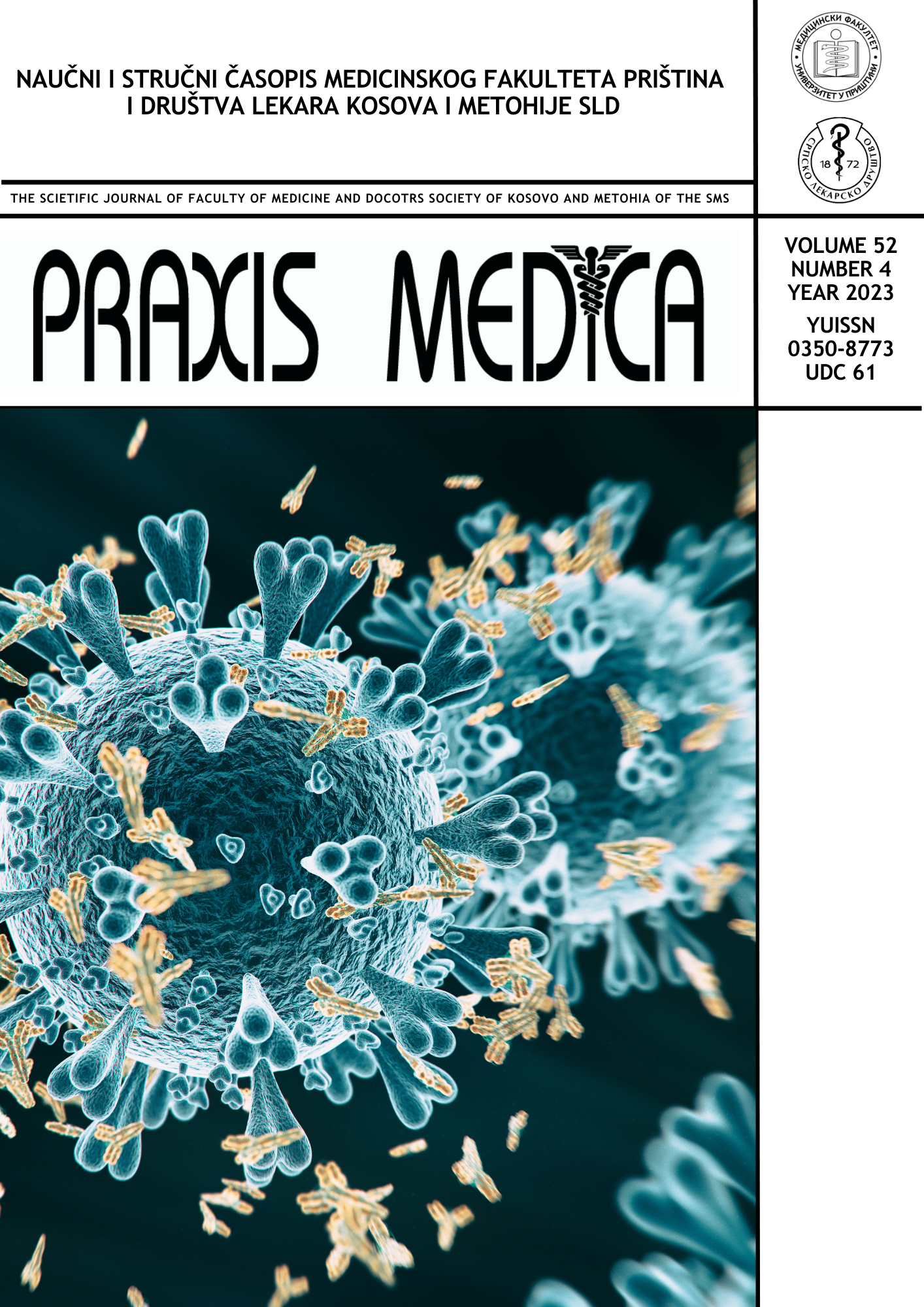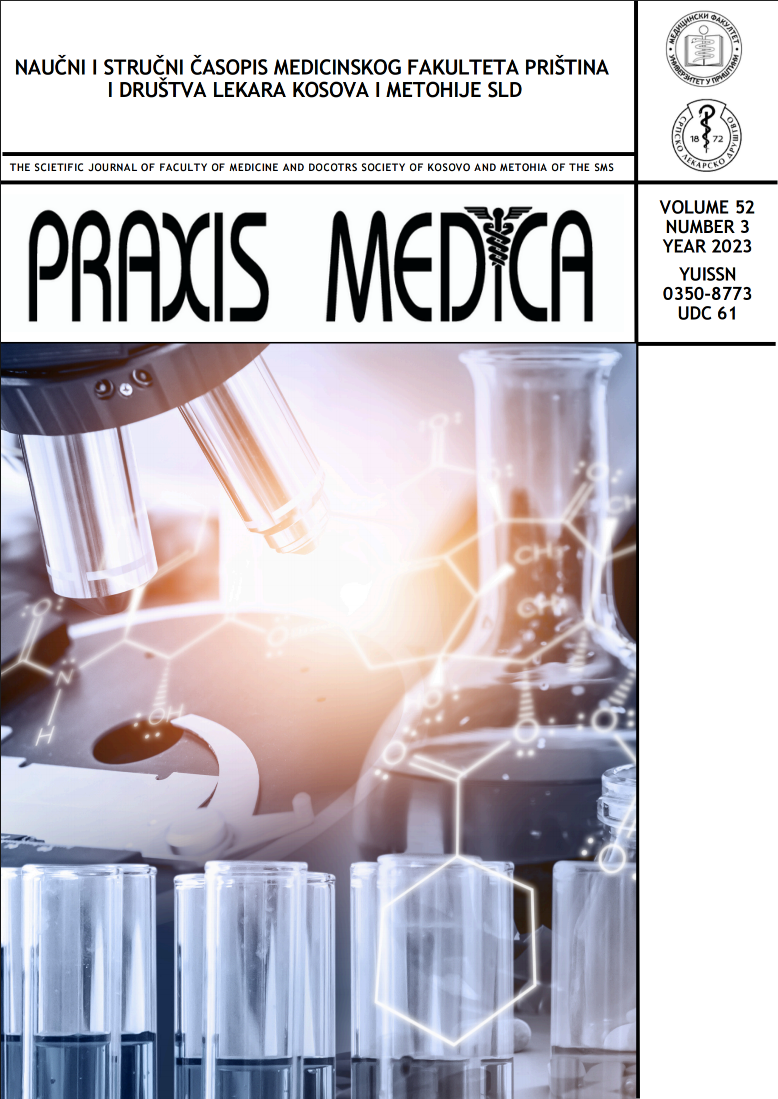Current issue

Volume 53, Issue 4, 2025
Online ISSN: 2560-3310
ISSN: 0350-8773
Volume 53 , Issue 4, (2025)
Published: 30.06.2025.
Open Access
All issues
Contents
01.12.2006.
Original scientific paper
EHOCARDIOGRAPHIC CHARACTERISTICS OF LEFT VENTRICLE IN NON-Q ACUTE MYOCARDIAL INFARCTION
In this work we have examined echocardiographic characteristics of left ventricle in patients with acute myocardial infarction (AMI). We used prospective study, during 12 months, and we followed 55 patients with diagnosed non Q AMI. All patients were hospitalized in the Coronary unit. Results: 55 consecutive (40 males middle age 55,4±8,7 and 15 females middle age 57,4±10,3) had non Q AMI. Value of ejection fraction: after 4.day - 50,4±6,2% ,2.weeks - 54,6±5,8%, 4. weeks - 59,3±5,4%. Value of ejection fraction in patients with thrombolytic therapy: 61,6±6,8% vs. 57,3±6,6% p> 0,05;Value of left ventricle fractional shortening: 28,8±2,5% (in patients with thrombolytic therapy 30,3±4,8% vs.27,2±5,9%) Value of end2 2 2 - diastolic volume: after 4.day- 62,5±5,3 ml/m , 2.weeks - 63,1±5,4 ml/m , 4. weeks - 64,4±5,8 ml/m (in patients with throm 2 2 2 bolytic therapy 60,5±9,2 ml/m vs. 67,4±8,4 ml/m ) Value of endsistolic volume: after 4. day - 26,2±2,1 ml/m , 2.weeks2 2 26,8±2,3 ml/m , 4. weeks - 27,6±2,2 ml/m (in patients with thrombolytic therapy 25,6±2,8 ml/m2 vs. 31,7±3,1 ml/m2 p> 0,05). During the in-hospital follow up period, 2(3,6%) patients and during the post-hospital follow up period, 1 (1,9%) patients with non Q AMI had lethal outcome.
S. Sovtić, S. Tomić, V. Trajković, A. Jovanović, Z. Marčetić, V. Perić, R. Stolić, T. Novaković, S. Lazić, S. Pajović
01.01.2006.
Case Reports
ADJUNCTIVE HYPERBARIC OXYGEN THERAPY IN THE TREATMENT KLEBSIELLA OSTEOMYELITIS OF FEMUR (A CASE REPORT)
Klebsilla pneumoniae is the very rarely cause of osteomyelitis in adults, most commonly in the immunocompromised patients with extra-sceletal infections. Successful therapy of chronic refractory osteomyelitis included different orthopaedic methods of treatment, the long time antibiotics therapy and more and more freaquently treatment with adjuvant hyperbaric oxygenation. We report an uncommon case of patient with chronic postraumatic osteomyelitis cased by dissemination of Klebsilla pneumoniae from urinary tract to place of osteosinthesis of femur. Treatment of this case of chronic refractory Klebsilla osteomyelitis finished successfuly after treatment with hyperbaric oxygenation two years from start of desease.
D. Mikić, G. Komljenović, S. Rudnjanin, S. Munitlak
01.01.2006.
Case Reports
RISK MANAGEMENT AMONG PATIENTS WITH SY GUILIAIN-BARRE AND ACUTE CHIRURGICAL DISEASE - presentation of the case with focus on the needed establishment of the national database of the risk cases
Every anesthesiologist can meet during his/her work with the patients who are suffering from rare diseases and had to be treated with surgical procedures. In a large clinical centers availability of the equipment, mentors and continual professional education are factors that are making performances of anesthesiologist's much easier. Regional hospitals, including our own one, are in much disadvantaged position. Health Center Kosovska Mitrovica is providing health treatment from the territory of Kosovo and Metohija. Due to the limited freedom of movement, these patients have to be treated "immediately and at place". Through the presentation of the case of the patient with Guillain-Barre (GBS) syndrome, we would like to underline a need for the establishment of the informational availability system through Point-of-Care Call on Line Electronic Help (OLEH) programme as it would significantly reduce the incidents related to the injuries and death cases caused by anesthesiologist procedures. Presentation of the case: Female, 42 years of age, a neurological patient with a th number of years of diagnosed illness was accepted on 13 February 2006 at the surgical department due to the abdominal pain, constipation and difficult urination. It was identified and diagnosticallv confirmed that uterus cancer spread out towards the colon, jeopardizing the bladder. It was decided that surgical procedure is reouired. Anesthesiology risk management evaluation started from the introduction with GBS. The case reviled acute inflammatory neuropathy with denivelization as the outcome of the antibodies reaction on the peripheral nerves. Chronically occurred types fas it was our easel, could lead to disruptions in breading, weakening of the muscle structure, areflection, pareses of orofaringealy physique, ophtamoplegy, chvadriplegy and chronical lung hearth. Strategy of the anesthesiological approach within the risk management procedures considered safe guidance of the patient through the pre and post anesthesioloqical period. Problem occurred was related to the limited availability of the professional literature and on-place resources related to the holistic experiences in treatment of this kind of problematic cases. The only sure available guideline was related to the avoidance of the depolarizing relaxants, which we have practiced. Within the work, we have described in details pre. peri and post anesthesiological approaches towards this problem. Conclusion: Recognition of the risk factors and multidisciplinary approach showed efficient during the peri and early post operational period. We have to indicate that development of the basic disease could have been much slower if we had assistance in respect to at-hand available and holistic information's on the rare diseases focused on the anesthesiological treatments. Therefore, it is our opinion that more qualitative system of health insurance has to introduce implementation of the hospital services standards, monitoring of the implementation and establishment of the electronic database. Developed countries such are i.e. USA, France, Italy, etc, have already introduced similar practices aimed to reduce morbidity and mortality among the patients
M. Cvetković, V. Cvetković, M. Nikolić, E. Vitić
01.01.2006.
History of medicine
RELATIONS OF THEORY, STRATEGY AND TACTIC IN PREVENTIVE MEDICINE TYPHUS ENANTHEMATICUS IN SERBIA IN 1914/15 R
Synonym Louse borne typhus represents the connection between Typhus exanthematicus and body lousiness. The results of the experiment Nicolle 1909 definitely established that. It is not explored how well the fact that Typhus is transmitted by body lice was known by doctors who were the actors of events in Serbia in 1914/15 year. A number of them categorically stated that they weren't aware of the results of Nicolla's experiments. Those honest doctors accused themselves that the fact not knowing made that “people paid by several hundreds of heads”, it was concluded that “they didn't know the theory and practice of Typhus epidemiology”. They thought that the epidemic disease would have had another direction if that had known that fact. In 1914/1 Serbia was “Typhus land stomach, recurrent and mysterious and violent Typhus”. It was the place where hypothesis “that destroying lice could be adequate proceeding in repress epidemic of Typhus” could be checked. On the epidemic culmination there was no any act or mean for effective total massive destroying lice. Disinfestations were the hygiene measure until 1915 year, and that wasn't anti epidemic measure. The working aim is to show the paradoxes: of doctors' self-accusing and confirmation on existing of special measures against Typhus. Descriptive method. Inspection in: professional, historic, fictive, accounts of its travels reviewers and archive origin on Typhus in the First World War. In 1914/15 there was no special epidemiology of Typhus. There was no effective tactic mean for massive disinfestations. Until then, nobody was stopping epidemic of Typhus bys strategy of destroying lice and their eggs. They didn't completely trusted Nicolla because current authorities believed that Typhus could be transmitted also by droplets' way. In the actual moment of epidemic culmination, the public's opinion was that disinfestations would be successful. Self-accusing of national doctors appeared after the success of English military mission. Kujachitsh was writing about Nicolla's experiments and he was a participant in war in 1914/15 and so he didn't look for a disinfestations (depediculation) mean and he didn't also strictly expressed himself on lice importance. Hirschfield, Subotitsh were looking for a mean for massive disinfestations; according to the results, they weren't successful. Scientific theory of Nicolla, and its prompt review by Kujachitsh, might be the base for positive movements, but also for tendentious “inflaming imagination” - “what could be if…”. We'll support the opinion how (the most) rationally the success could be reached: 1) what was cumulatively hypothetic by proofs becomes cumulatively confirmed; 2) supporting better stages in reaching the truth. Further appearance of sick could be added to failure: a) of tactic solution; or/and b) a strategy; or/and even solidly proved c) start, experiment of Nicolla. Interdependence is maximal first not proved conditions that the following one is problematic. There were no intention to prove that “disinfestations was successful for eradication of Typhus”, and from that appeared the failure of chosen mean, organisation of proceeding and so on, it could influence valuation of strategic result, instead of having reliable knowing on disinfestations power as a motive for finding means. The fruit of the projection and emotions is a prejudice that Nikola's theories is self-sufficient in order to make epidemic resulted in significantly less number of victims from Typhus if that had been known because all of the rest would be just result; that Stammer's mean could be easy to find. All of this produced repentance and self-accusing a number of honest doctors and that was stressed further, and it was never put under consideration although it came only after final happening. Successful tactic solution was uncertain if it was going to be found at all. Ranges of tries were not successful (Subotitsh, Hirschfield and so on). Stammer's “Serbian barrel” was enough for stopping dangerous large epidemic scale. Hunter had a planned approach to eradicate Typhus by disinfestations (depediculation), he applied that new strategic measure in the whole territory of Serbia, in: the Army, national and displaced population, as well as among the prisoners. Mostly thanking to Nicolla, only after epidemic in Serbia in 1914/15 the adequate synonym to Typhus is “Lousy Typhus”. The special epidemiology of Typhus was not constituted until 1919, and so
the valuation of not knowing the theory and practice (of special epidemiology) of Typhus was not applicable to time in 1914/15. There are no guilty ones for death of Typhus in Serbia in 1915 among the doctors. Informing that lice transmit Typhus meant that in looking for disinfestations procedure “there was no more in obligation, but more in opportunity”. Success of Stammers classifies himself among the “unusual” ones. Success of English military mission with Hunter on the top, made that Golgotha exceeded into epopee. The typhus from then always used to lose its battle.
G. Čukić
01.12.2006.
Original scientific paper
VITAMIN C CONCENTRATIONS IN SERUM BEETWEN PATIENTS SUFFERING FROM DIFFERENT FORMS OF NON-SPECIFIC OSTEOMYELITIS
Bone tissue infections caused by non-specific agents (non-specific osteomyelitis) occur most frequently among children and young individuals demanding surgical and antibiotic therapy, although with unpredictable clinical outcome. While mobilization of cellular response to infectious agents takes place, a bulk of oxygen-derived free radicals emerge with concomitant participation of various elements of endogenous antioxidative defense. Vitamin C is an endogenous antioxidant active in the aqueous phase. It is very likely that ostoemyelitic patients already have some kind of disorder in specific antioxidant system due to hematogenic origin of non-specific osteomyelitis. Our results show that serum total vitamin C concentrations among patients with non specific osteomyelitis are not significantly different from those obtained among control subjects. However, we found significantly different concentrations of ascorbate, dehyroascorbate and their concentration ratio in serum within osteomyelitic patients that points to enlarged consumption of ascorbate even before the bone localization of infection took place
D. Mirić, R. Grbić, A. Vasić, B. Božović, I. Dragojević, M. Marković, V. Nestorović
01.01.2006.
Professional reviews
DIFFERENTIAL DIAGNOSIS OF PUSTULA MALIGNA
The pustula maligna is most often clinical form of antrax. Disease is today a relative Rarity, but its appearance (sporadic or in epidemia) always to be surprised, especially in the biology war. Antrax have a big significant and today, we analyzed clinical findings of pustula maligna and its differential diagnosis.
M. Relić, C. Vujičić, L. Dejanović, N. Krstić, J. Ivanović
01.01.2006.
Professional reviews
MONITORING THE ADVERSE ADVERSE DRUG REACTIONS REACTIONS TODAY
One the of most importante charactersistics of drug is a drug safety. However, there is no absolute safety. Medicines are troughly tested in controlled clinical trials with limiting population and short duration. Experience has shown that much of our knowledge about a medicine becomes available during the subsequent prescribing practice. Therefore there is a need for continued monitoring medicines after granting of product licence for a new drug (phrmacovigilance). WHO international system for drug safety monitoring as maintained by the Upsala Monitoring Centre (UMC) in Sweden, has built up vastedatabase of reports of suspect adverse drug reactions, coming from national centres in 75 countries in all of the world. The international system products valuable information from countries around the world, to support regulatory follow-up and decision-making. Emphasis is on those signals that may remain at the national level, because of small numbers or absence of local reports. The aim of the WHO's international pharmacovigilance program is a safe and rational medicines evrywhere. In Serbia as of 2005. National Medical Devices Agency is acting on behalf of the Ministry of Health as National Centre for Adverse Drug Reactions. The form for reporting adverse effects of medicines, in both pre-marketing and post-marketing phase can be found and downloaded in Word format on the Agency`s web site www.alims.sr.gov.yu.
S. Janićijević-Hudomal, J. Rašić, R. Mitić, Z. Stanojević
01.01.2006.
Professional reviews
REACTIVE OXYGEN SPECIES
Reactive products of oxygen are among the most potent and omnipresent threats faced by the living organism. Intracellular accumulation of reactive oxygen species such as superoxide anion, hydrogen peroxide, hydroxyl radical, and peroxy radical, can arise from toxic insults or normal metabolic processes. These species may perturb the cell's natural antioxidant defence systems, resulting in damage to all of the major classes of biological macromolecules, including nuclear acids, proteins, carbohydrates and lipids. Oxidative stress has been defined as a disturbance in the prooxidant-antioxidant balance, resulting in potential cell damage. It has been implicated in several biological and pathological processes like ageing, inflammation, carcinogenesis, ischemia-reperfusion and in diseases including diabetes mellitus, atherosclerosis, and/or neurodegenerative diseases
B. Kisić Božović, D. Mirić, M. Dragojević, I. Dragojević
01.01.2006.
Professional reviews
DIABETIC NEPHROP IABETIC NEPHROPATHIA AND ACE INHIBIT ACE INHIBITORS
Diabetes is the most common cause of end-stage renal disease .in United States , Europa and Japan. Approximately 40% of patients with type 1 diabetes and 5-15% of patients with type 2 diabetes eventually develop end-stage renal disease. Risk factors for development of diabetic nephropathy include hyperglycemia, hypertension, positive family history of nephropathy and hypertension, and smoking. Key elements in the primary care of diabetes include glycemic control, blood pressure control, and screening for microalbuminuria. In general, the goal for glycemic control is a blood glucose level as close to normal (HbA C <7%) . Blood pressure control is at least as important as glucose control, especially after the onset of 1 renal damage, and blood pressure should be consistently <130/85. Screening for diabetic nephropathy involves monitoring at least yearly for urinary albumin excretion >30 mg per day. Microalbuminuria is defined as the urinary excretion of 30300 mg of albumin per day. Both glycemic control and rigorous control of blood pressure have significant impact on prevention and progression of diabetic nephropathy. Identification of patients with microalbuminuria selects a population of patients with increased mortality. Microalbuminuria screening should begin at the time of diagnosis. ACE inhibitors should be used when microalbuminuria is present regardless of the presence or absence of hypertension in type 1 diabetes and are widely.
used in normotensive patients with type 2 diabetes, as well.The effect of ACE inhibitors is probably not only via lowered
systemic blood pressure but also via direct effects on intraglomerular hemodynamics.
T. Novaković, S. Jovanović, S. Sovtić, S. Pajović, R. Stolić
01.01.2006.
Professional reviews
PLACE OF ZINK PREPARATION AS DIETETIC SUPPLEMENT IN NON-INSULIN-DEPENDENT DIABETES MELLITUS
Considering its importance in cell replication and differentiation, programmed cell death, DNA transcription, function of hormones, biological membranes and immunological system, zinc probably has a major role in enabling a proper
function of different tissues, organs and organic system in general. As an essential micronutrient wich is directly involved in metabolizm of insulin, zinc play important role in pathogenesis of diabetes mellitus and its complications. On the other hand, low zinc absorption and hyperzincuria in diabetic animals and humans have indicated that diabetics are more susceptibile to zinc deficiency compared to healthy persons. Inasmuch as zinc plays an important role in syntesis, storage and secretion of insulin as well as conformational integrity of insulin in the hexameric form, zinc deficiency may adversely affect the ability of the islet Numerous studies suggested that urinary zinc excretion was higher in diabetes mellitus, probably as result of hyperglycemia. In contribution, there are findings about correlation between urinary zinc excretion and blood glycosylated hemoglobin (HbA1c) levels in non-insulin dependent diabetic patients. Recent experimental investigations showed that zinc supplementation inhibited NF-kB activation in the pancreas and decreased the expression of inducibile nitric oxide synthase, a downstream target gene of NF-kB. The ability of zinc to modulate NF-kB activation in the diabetogenic pathway may be the key mechanism for zinc's protective effect and important criterion for choosing nutritional strategies for diabetes mellitus prevention.
Z. Stanojević, R. Mitić, S. Stević, Z. Bukumirić, B. Biševac, M. Miletić, S. Bulajić











